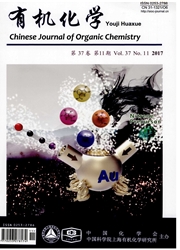

 中文摘要:
中文摘要:
首先通过改进的Hummers法制备了氧化石墨烯(G0),然后通过酰胺化反应将端基为氨基的六臀浆乙二醇(PEG)连接到氧化石墨烯的表面,以改善其水溶性和生物相容性.原子力显微镜(AFM)数据表明所制备的GO—PEG的尺、川、r250rim,稳定性试验证明GO—PEG在水和PBS缓冲液中可以很好地分散.利用制备的GO—PEG作为药物载体.通过物理共混的方法负载了疏水性抗肿瘤药物——毛萼乙素.紫外光谱法测得载药率为18.8%.选择肺癌细胞A549和乳腺癌细胞MCF一7对载药体系的细胞毒性进行了研究,结果表明即使在高达100mg/L的浓度下培养48h,GO—PEG载体对两种细胞仍然具有很小的毒性(相对细胞存活率〉85%),而通过载体负载毛萼乙素后的疗效有所增强,对癌细胞只有
 英文摘要:
英文摘要:
Graphene oxide (GO) was firstly prepared by modified Hummers method. In order to improve its water solubility and biocompatibility, 6-arm PEG was grafted to GO via a facile amidation reaction. The size of obtained GO-PEG was less than 250 nm. Stability test indicated the good dispersibility of GO-PEG in water and PBS buffer. Furthermore, eriocalyxin B, a widely used cancer chemotherapy drug, is adsorbed onto GO-PEG via physical blending with a drug loading ratio of 18.8% obtained by UV spectrum. Lung cancer cell A549 and breast cancer cell MCF-7 were selected to study the cytotoxicity ot GO-PEG/eriocalyxin B, GO-PEG, and free eriocalyxin B. The results demonstrated that GO-PEG nano-carrier possessed low toxicity (relative cell viability〉85%), even cultivated for 48 h at a relatively high concentration of 100 mg/L. Compared to pure drug, GO-PEG/eriocalyxin B nanocarrier shows higher cytotoxicity in A549 and MCF-7 cells.
 同期刊论文项目
同期刊论文项目
 同项目期刊论文
同项目期刊论文
 Analysis of 20-OH-Ecdysone Titers in Ostrinia furnacalis Affected by Azadirachtin Using Capillary Zo
Analysis of 20-OH-Ecdysone Titers in Ostrinia furnacalis Affected by Azadirachtin Using Capillary Zo Inhibition of type I insulin-like growth factor receptor tyrosine kinase by picropodophyllin induces
Inhibition of type I insulin-like growth factor receptor tyrosine kinase by picropodophyllin induces Comparative studies of tri- and hexavalent chromium cytotoxicity and their effects on oxidative stat
Comparative studies of tri- and hexavalent chromium cytotoxicity and their effects on oxidative stat Genotoxicity of Tri- and Hexavalent Chromium CompoundsIn Vivo and Their Modes of Action on DNA Damag
Genotoxicity of Tri- and Hexavalent Chromium CompoundsIn Vivo and Their Modes of Action on DNA Damag PhosPhatidate PhosPhatase-1 is functionally conserved in liPid synthesis and storage from human to y
PhosPhatidate PhosPhatase-1 is functionally conserved in liPid synthesis and storage from human to y One-Step Preparation of Fluorographene: A Highly Efficient, Low-Cost, and Large-Scale Approach of Ex
One-Step Preparation of Fluorographene: A Highly Efficient, Low-Cost, and Large-Scale Approach of Ex 期刊信息
期刊信息
